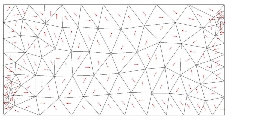XXXXXXXXXXXXXXXXXXXXXXXXXXXXXXXXXXXXXXXXXXXXXXXXXXXXXXXXXXXXXXXXXXXXXXXXXXXXXXXXXXXXXXXXXXXXXXXXXXXXXXXXXXXXXXXXXXXXXXXXXXXXXXXXXXXXXXXXXXXXXXXXXXXXXXXX''"> 2D Material Orientation
2D material orientation only applies when the orthotropic or anisotropic material is referenced. The brackets [ ] indicate optional input.
MSC Sinda for Patran provides three options to define 2D material orientation.
All methods will ultimately lead to a material angle for the translator. The material angle is the angle between material CS and element CS. Its unit is in degrees, not in radians. By default, the material angle is 0 degree, unless the material orientation is defined by the following options.
Real Scalar Option – specifies the material angle directly, needing just one floating point number. The material angle is in degrees. It is the angle between material orientation (

direction) and element X direction (node1 to node2 direction).
Vector Option – is a way to compute a different material angle for each element. MSC Sinda for Patran provides different ways to define the vector. The user can either input a vector directly or select one of the existing vectors. The vector is projected into the plane of the element, and the projected vector used to compute the material angle.
CID Option – The user can select any CID and then one of the 3 axes to align the

material direction. This may result in different vector directions that depend on locations and the types of coordinate system.
If the material orientation is empty, it means no material orientation is applied. The material direction will be the same as the element X direction (node1 to node2 direction).
For very simple and regular rectangular meshes, the real scalar option (or material angle = 0) is often the simplest approach, but for more arbitrary and irregular meshes this does not work. This figure shows an example of the irregular mesh in which the element X direction varies randomly. Without proper specification of the material angle, this model will produce incorrect results. Arrows show each element’s X direction. Also shown are the results obtained when the material orientation is not set or constant material angle is used. The results show obvious mesh-dependencies and are incorrect. Switch to the Nastran preference, and use /Utilities/Display/Plot Material Orientation/ to show material orientations on 2D elements.


In the previous case, the CID or Vector option should be used, because it would take a long time to specify the material angles one at a time. These options can be used for any type of mesh. The translator will automatically calculate the material angle for each element. Each element has its own material angle, but the material orientation is the same for the whole model. The following figures show the results obtained when the material orientation is specified correctly.
The coordinate systems can also be cylindrical or spherical. For cylindrical coordinate systems, choosing axis 3 is similar to picking a vector, but choosing the R or

axis results in a “variable vector”. The “R direction” and the “

direction” depend on where the point is located in 3D space. In a spherical coordinate system, the R,

, and

directions are all variables.


